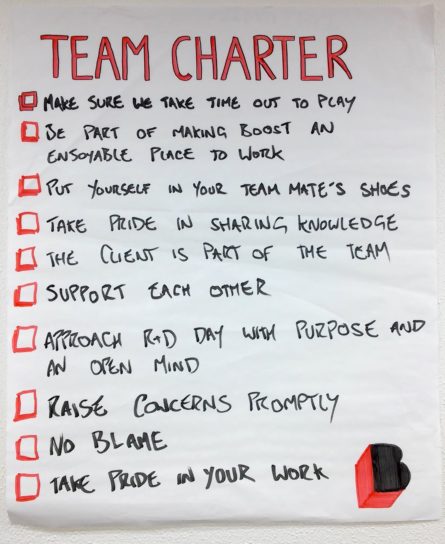By Nick Butler

Government of the team, by the team, for the team—that’s the Agile Team Charter.
At Boost we usually wrap up our Project Kick-off workshops by discussing how the team will work together and documenting this in the Team Charter. Beyond the discovery workshop, it’s also a very useful exercise for new teams or when new people join an existing team.
Get the Agile Project Kick-off Kit as a handy 39-page PDF. Based on this blog post series, it’s been revised and expanded, giving you the tools you need to get your project off to a successful start.
As with all the best professions (doctors, lawyers, the mafia), the aim is to be self-regulating. You’re more likely to get a great team when the team itself sets the ground rules. It bonds the team and builds a shared understanding and commitment.
“We have the Team Charter at the end of the agenda because it’s a good way to frame things,” says Agile Lead Gavin Coughlan. “You’re about to embark on this journey together so it’s a nice to bring people together and get a shared understanding of how you want to work. You start building the team through having that conversation.”
Team Charters range from the lightweight to the kind of encyclopedic detail suggested by the Scrum Alliance.
“I think there’s a good middle ground,” says Gavin.
As a rule of thumb, if it’s too big to remember, it’s probably too big.
At Boost we usually cover:
We sometimes cover:
We don’t cover:
Some Charters start as a list of rules presented to the team which Gavin advises against.
“It’s a hard ‘no’ to that,” says Gavin. “That would be favouring process over individuals and interactions. You can’t expect buy-in from the team if they have limited input into their own charter.”
You don’t need the stakeholders who have been part of the rest of the Kick-off, just the team—including the Product Owner—and the facilitator.
“Usually when you open a Team Charter meeting and you say, ‘OK, what’s our first point?’, it’s tumbleweeds,” says Gavin.
To break the silence, the facilitator should avoid making suggestions and instead should ask open questions. These might be things like:
Capture each point, perhaps on a flipchart or whiteboard. Make sure each point clearly describes what was intended and is understood by everyone. When the points stop coming, review them all to make sure they’re relevant and there are no big gaps.
At Boost we have both a physical and a digital copy, the paper version posted beside the project board and a photo or transcript in our wiki.
The physical copy keeps the Charter in front of the team every day, while the digital copy is available for people working off-site and as a back-up.
“If we just put it up electronically no one would probably ever look at it again,” says Gavin.
It’s worth taking the time to make it tidy. “If it doesn’t look good it’s not showing a lot of respect for the Charter.”

Just as the Team Charter is not laid down from on high, it’s also not carved in stone.
“You want to maintain it, but not so frequently that people get sick of it,” says Gavin.
A Retrospective can be a good chance to review the Charter and make sure it’s still fit for purpose.
Gavin gives the example of a team that had decided they were not going to interrupt each other when they had their headphones on because that meant they were in the zone.
“But then we found that people had headphones on all day long,” he says.
If you do make changes, update both the paper and electronic versions.
“The Team Charter is not something you use to police a team,” says Gavin, “it’s something the team can use to hold each other accountable. So if someone arrives late for a meeting they can say, ‘Hey, we agreed that if you were late you’d message the team so we know you’re OK.’”
Sometimes Agile coaches notice the Charter isn’t being followed and remind the team that it’s there, and that it’s theirs.
“A team I worked with before was having problems, they weren’t communicating well,” says Gavin. “We got them together, ran a team-building exercise and took a look at the Team Charter. We had a really open and frank conversation about their approaches to things and how their approaches differed. Like most tools in Agile, it’s all about the conversation—the conversation about the points in the Charter helped create a new understanding. When we put the Charter back up on the wall the team referred to it all the time. It was probably the best, the most impactful Team Charter I’ve ever seen.”
This post is part of a series covering the tools and templates you can use for a Project Kick-off.
Get the Agile Project Kick-off Kit as a handy 39-page PDF. Based on this blog post series, it’s been revised and expanded, giving you the tools you need to get your project off to a successful start.
Watch The Board episode on Project Kick-offs
Read about the Team Charter for our Scrummaker project Kick-off
In New Zealand and keen to train with the team who put together the Kick-off kit? Learn more about our Agile training:
Agile Professional Foundation certification, Wellington, NZ – two-day ICAgile course
Introduction to Agile methodology, Wellington, NZ – free two-hour workshop
Agile Accelerator team assessment – Agile review and action plan